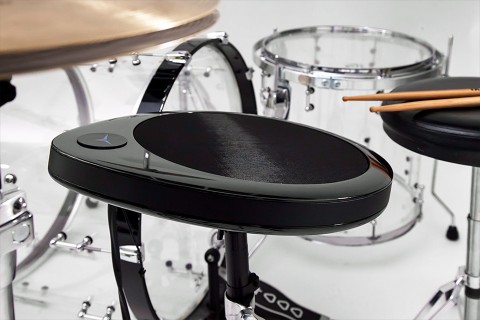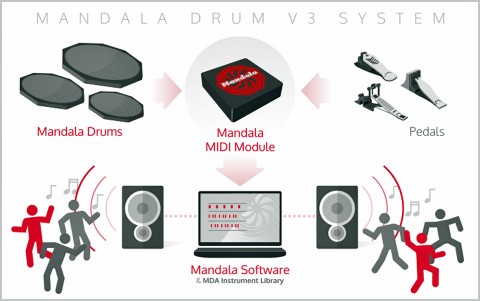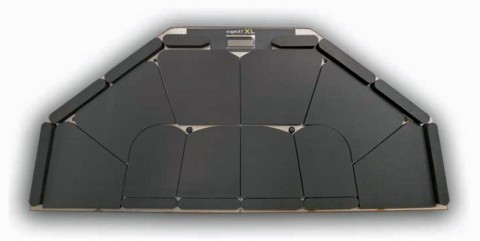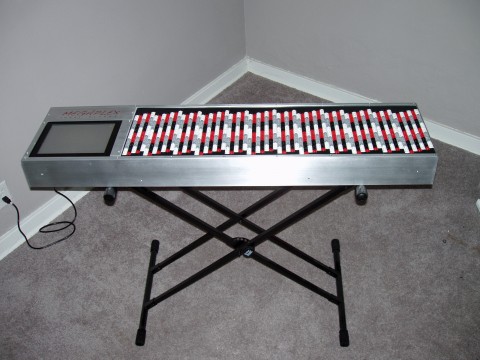Alternative Controllers: Part 5 Hand-Held and Struck Controllers, and Controllers for Microtonal Tunings
Hand-Held Controllers
Electronic MIDI controllers that you hold in your hands and shake or move about to make music date back to 1986. That was the year Palmtree Instruments introduced Airdrums, a tabletop MIDI controller wired to two tubes that contain sensors for detecting motion in any of six directions. The control box transmits six triggers per tube for playing notes, starting sequences, and generating other MIDI data depending on user assignments. Airdrums started the ball rolling in the development of controllers such as the Nintendo Wii, which some contemporary performers use as a softsynth controller.
Also in 1986, computer-music pioneer Max Mathews (1926-2011) introduced the Radio Baton, which consists of a pair of mallets with built-in radio transmitters and a table surface beneath which are five antennas. As a computer loaded with Max’s conductor software follows movements of the mallets above the table, it generates MIDI output for controlling the volume, timbre, and rhythm of a sequencer playing music.
Don Buchla introduced Lightning in 1991. It has two wireless wands that contain infrared transmitters, a remote infrared-tracking head that can be mounted on a mic stand and senses positions of and gestures made with the wands, and the third component, a half-rack-sized box that contains electronic circuits. You can program the receiver that tracks wand movements to perform actions such as note selection, pitchbends, stereo panning, and volume. Originally Lightning only transmitted MIDI, but the newer version — the Buchla Lightning III — transmits MIDI and also has a built-in 32-voice synthesizer.
Imagine if the batons held by a member of the ground crew to safely direct an aircraft into a gate at an airport controlled the pitch, timbre, and other aspects of sound generated by a synthesizer. That’s essentially what Don Buchla’s Lightning does. This is the Lightning II system, complete with the triangular, optic-sensing head, a pair of wireless, infrared-transmitting wands, and the half-rack control module, which housed a 32-voice synthesizer. Lightning II was introduced in 1996, later to be replaced by the Lightning III. (courtesy of Buchla & Associates)
Synthesizer pioneer Don Buchla — proudly clad in his pin-laden fedora — prowls the Anaheim Convention Center at Winter NAMM 2012. (Mark Vail)
Struck Controllers
Numerous individuals and companies have made electronic controllers and instruments for drummers and percussionists since Joe Pollard developed the Syndrum in 1977. Soon to follow were the U.S.-built Star Instruments Synare series from 1975 to 1983 and the British-made Simmons pads and sound generators.
Plenty of drum and percussion controllers and systems have come and gone since MIDI arrived in 1983. Among the manufacturers to develop full-fledged electronic kits are Alesis, 2Box Music Applications, Roland, and Yamaha. All of them make modules to go with the drum pads and related controllers — cymbals, too — but of course since they’re MIDI controllers you can trigger any MIDI sound generator(s) of your choice.
Drum controllers don’t have to look like drum sets. Over the years there have been many great percussion controllers and instruments, whether you hit them with sticks — Roland’s Octapad series comes to mind — or your hands — i.e., Roland’s Handsonic series. As of November 2015 Roland’s current Octapad is the SPD-30 (http://www.rolandus.com/products/octapad_spd-30), which contains built-in sounds and can function as a percussion instrument on its own. If you’d prefer an electronic percussion instrument/controller that allows you to sample your own sounds, Roland offers the SPD-SX (http://www.rolandus.com/products/spd-sx). Both SPD models have MIDI I/O for playing other instruments or responding to controller and note data from other MIDI devices, as well as trigger inputs for responding to analog gear that output trigger signals.
Continuing the historic line of Octapads, Roland’s SPD-30 sports features including eight pads, four inputs for triggers from external sources, a backlit LCD, 670 internal sounds, built-in effects, and a three-part phrase-loop sequencer that allows overdubbing. (courtesy of Roland Corporation)
Roland’s SPD-SX allows you to sample and play sounds using its nine velocity-sensitive pads, six square and three across the top. It provides 2GB of internal sample memory, effects processing, a backlit LCD, MIDI and USB connectors, and two external trigger inputs. The SPD-SX comes with computer software for importing, assigning, and organizing samples. (courtesy of Roland Corporation)
Although I’m a poor percussionist and never came close to mastering the drums, Roland’s introduction of the HPD-15 Handsonic at the 2000 NAMM show immediately attracted me thanks to its built-in sounds and controller implementation. Its 15 pads, arranged within a circle and sized between about a quarter of the circle and a few square inches, sense how hard you strike them with your hands and fingers — drumsticks aren’t recommended — as well as how hard you push down afterward. In fact, each Handsonic transmits its own aftertouch data, which means it will work with MIDI devices that detect polyphonic aftertouch — a rare but very effective means of imparting vibrato or a bit more volume to individual notes within a chord. In addition, the HPD-15 has two ribbon controllers — one on each side of the pad circle — that can trigger notes or transmit controller data. Finally, the HPD-15 has a D-Beam controller, a motion-sensing detector placed above the pad circle; it too can trigger notes or send controller data.
While the original HPD-15 Handsonic has been discontinued, as of late 2015 Roland’s flagship Handsonic, the HPD-20 (http://www.rolandus.com/products/handsonic_hpd-20), offers the same pad configuration and D-Beam, although not the side ribbons — which makes it less wide and a bit more portable than the HPD-15. Along with 850 internal sounds, the HPD-20 allows you to import up to 500 of your own WAV-format samples.
Thanks to its responsive silicone rubber pads, great sounds, and extensive programmability, the Roland HPD-20 serves as an outstanding electronic percussion instrument. Hitting it with drumsticks isn’t recommended; use your hands, please. (courtesy of Roland Corporation)
The configuration of pads on John Worthington’s Jambé (http://getjambe.com) reminds me of those on a Roland Handsonic, except that you can hit the Jambé’s with your fingers, hands, or drumsticks and it’s intended mainly as a percussion controller for an iPad or iPhone. Activity on Jambé’s pads transmit controller data including aftertouch. The latest developments in Jambé’s software and sounds are due to be announced at Winter NAMM 2016, from January 21 to 24. It’s a beautiful controller that might work perfectly for you.
Mounted on a drum stand above an Apple iPad is a Jambé percussion controller. You can order a Jambé with its wooden rim stained light or dark. According to the Jambé website, “Within a sustainable hardwood rim sits a ten geometric play zone interface which transforms actions registered by its sensors into dynamic sounds via software running on an iOS device.” (courtesy of John Worthington)
Taking a slightly different controller approach is Titan Reality, whose Pulse 3D music controller (https://titanreality.com) responds not only to direct contact on its surface, but also to movement and hand gestures the performer makes above that surface. You can play Pulse with your fingers or hands, as well as mallets, drum sticks, brushes, and other objects such as a ball. As stated on the Titan Reality Kick Starter site, Pulse is “the musical instrument platform of the future, for everyone to discover and play music at any level. … Pulse is the most expressive music controller ever made, it works in 3D, at very high resolutions and speeds. When connected to a free Titan Reality app you can play instruments with incredible detail and performance. Simply discover thousands of high-resolution musical instruments in a one-click app using our Explore cloud platform. The system is also compatible and fully programmable with all standard music software using MIDI.”
The site describes Explore as “a new digital platform that brings the simplicity of cloud distribution to music makers. Browse, listen, choose, and download any item instantly, so you can setup your ideal music rig in a few clicks.
“You can download any of the new 100+ instruments coming to Explore each month. Discover and play rare, luxury and handmade instruments from private collections or cutting edge electronic instruments in your home, at a fraction of the price. Combine these state of the art virtual instruments with the control of Pulse and play musical history. Explore will be available after our Kickstarter campaign.”
A Titan Reality Pulse controller set up in place of a snare drum with a clear-shelled drum set. (courtesy of Titan Reality)
Another exciting new instrument/controller going through an IndieGoGo Crowdfunding campaign as of November 2015 is the Synesthesia Mandala Drum V3 System (http://www.MandalaDrum.com). It’s an advanced drum-pad controller system co-developed by engineer/inventor Vince De Franco — maker in 1997 of the Interactive Light Dimension Beam, which Roland subsequently licensed and incorporated as the D-Beam controller in the HPD-15 Handsonic and other electronic instruments — and drummer Danny Carey of the band Tool. So sensitive is the Mandala V3 pad at tracking the position and force of individual hits on its surface and rim that you can trigger and control thousands of samples from a single pad.
You can connect up to seven V3 pads to a single V3 Module. Synesthesia’s V3 Virtual Brain Software — which can function as a stand-alone application or as a plug-in for Ableton Live, Logic, ProTools, Cubase, Digital Performer, and MainStage — allows you to assemble and trigger non-proprietary MDA sound files consisting of a single to thousands of location, velocity-switched, and round-robin samples. Mandala Drum V3 System creators incorporate a patented membrane switch that reportedly detects the position and velocity of any touch on the surface or rim with no false triggers. They intend the Mandala Drum V3 System to expand a drummer’s creative, compositional, and performance capabilities with integrated hardware, software, and included MDA sound-file library, as well as additional MDAs available from the company’s online library.
A close-up look at a Synesthesia Mandala Drum V3 pad. (courtesy of Synesthesia Corporation)
Included here to his left in Tool drummer Danny Carey’s drum kit are two Synesthesia Mandala Drum V3 pads. Carey worked with Vince De Franco to develope the Mandala Drum and plays seven Mandalas in his official Tool drum kit. (courtesy of Synesthesia Corporation)
This graphic depicts the process Synesthesia conducts to create an MDA based on a snare-drum sound from late Led Zeppelin drummer John Bonham for assignment to a Mandala Drum V3 pad. (courtesy of Synesthesia Corporation)
A visual layout of a Mandala Drum V3 system. What’s referred to here as the Mandala MIDI Module corresponds to the Mandala V3 Module. (courtesy of Synesthesia Corporation)
One manufacturer has been making percussion controllers since the mid 1980s in Chicopee, Massachusetts, originally as Kat and now as Alternate Mode (http://www.alternatemode.com). Their ten-pad drumKat is an expressive controller that has gone through numerous updates since its early ’90s introduction. The bigger and more extensive trapKat provides 24 trigger pads across its 41.5″ by 19″ surface. Both supply user memories and lots of programmability in a single unit that’s far easier to tear down, transport, and set up than an entire electronic drum kit.
Alternate Mode’s programmable drumKat controller allows you to trigger MIDI synths to play drum, percussion, or whatever sounds you choose. You can program individual pads to transmit single notes, melodic lines, or up to eight notes at a time. If you’d prefer a complete instrument, there’s the drumKat Turbo KS, which has a built-in Kurzweil synthesizer. (courtesy of Alternate Mode, Inc.)
Trigger pads are spread out wide on the Alternate Mode trapKat controller. How many pads? If you count — be sure to include the skinny ones around the perimeter and across the front — you’ll get up to 22, but there are actually 24. The pads to the extreme left and right are actually spit in half to serve as two pads each. Connected to one or more capable MIDI sound generators, you can assign up to 16 sounds to each pad and trigger them individually by velocity switching among them, layer them all together, or sequence through them one at a time. Also available is the trapKat 5KS, which includes a built-in Kurzweil synth engine. (courtesy of Alternate Mode, Inc.)
Steel drums have always fascinated me, as well as the music played with them. How would you like to have one that you can play any sounds you’d like on? Introducing the panKat MIDI controller from Alternate Mode. It gives you 128 memory locations to store your assignments of its 30 trigger pads. (courtesy of Alternate Mode, Inc.)
Alternative Mode’s malletKat Pro provides three octaves of trigger pads arranged like the bars of a marimba. The malletKat is also available in two- and four-octave models — the Express and Grand, respectively — and you can get any of them with a built-in Kurzweil synth engine. You can also buy a single-octave pad expander to increase the note range of any malletKat. (courtesy of Alternate Mode, Inc.)
Another marimba-style controller came from Don Buchla, who teamed with percussionist/programmer Mark Goldstein and marimbist/sound designer Joel Davel to create the Marimba Lumina mallet MIDI controller/instrument — Buchla’s final 20th century product. It was available in two sizes, responds independently to as many as four different mallets for gestural control, and features a built-in synth engine for stand-alone performance.
Controllers for Microtonal Tunings
The 12-notes-per-octave equal-tempered scale we’re accustomed to hearing in Western music is in truth a compromise in tuning, adopted during the early 19th century mostly to allow easy transposition into different keys. Whereas such a division of the octave results in unnatural tuning beats in intervals such as a major third or fifth because frequency ratios between the low and high notes are sharp or flat, tunings based on frequency ratios such as 5:4 for a major third and 3:2 for a perfect fifth in Just intonation result in pure, beat-free interactions between the low and high notes. Explorations of Just Intonation and other microtonal tunings — including equal-tempered scales in which the octave is divided into increments such as 53, 41, 31, or 7 — can be fascinating, rewarding, and potentially never-ending.
Not only are Just intonation and other non-equal-tempered and microtonal tunings infinitely easier to do with synthesizers — many of which support different tunings, some more flexibly and easier to program than others — than with acoustic instruments, but there’s also a variety of controllers and instruments specifically tailored for playing microtonal music. The widest variety appears among the offerings in the Tonal Plexus lineup from Hπ/H-Pi Instruments (http://hpi.zentral.zone/tonalplexus). Invented and hand-made by Aaron Andrew Hunt, these complex, colorful instruments range from two to six octaves with blue, green, red, or yellow edge keys. The keyboards are part of a complete system of microtonal music theory that is quite unique, historically speaking (http://musictheory.zentral.zone/huntsystem1.html). A Tonal Plexus can have either MIDI I/O or a USB connector (the U-Plex line), and some are available with built-in General MIDI sound generation and a stereo sound system with internal speakers and a headphone jack. Every Tonal Plexus instrument comes with cross-platform editing software and a ¼” sustain pedal input jack.
The MegaPlex from Hπ/H-Pi Instruments is an experimental version of the Tonal Plexus series with 256 velocity-sensing keys per octave covering six octaves. Built-in are a Mac Mini with all of its connections — HDMI, Ethernet, mic input, two USB ports, and Firewire 800 — accessible on the back panel, a 1,024 by 768 TFT LCD single-touch screen, and a built-in stereo sound system with line-level input and output and a headphone jack. Alongside the MIDI in, out, and thru connectors are six ¼” jacks for foot controllers. Although you can run the Macintosh music applications of your choice, H-Pi’s microsynth comes installed on the MegaPlex’s internal Mac Mini, which requires a USB keyboard and mouse to boot up, but the built-in touch screen works directly with the Mac. (© 2012 H-Pi Instruments)
A close-up look at the built-in touch screen on the H-Pi Instruments Tonal Plexus MegaPlex. (© 2012 H-Pi Instruments)
A view from behind an H-Pi Tonal Plexus MegaPlex. As of April 2015, H-Pi’s Aaron Andrew Hunt reports that he’s taking a break from hand-assembling Tonal Plexus keyboards, which he did from 2006 through 2014. Other than finding a Tonal Plexus on the used market, alternative-tuning enthusiasts who seek a Tonal Plexus keyboard might still be able to purchase one directly from H-Pi in the form of a DIY project (http://hpi.zentral.zone/diy) or prototype (http://hpi.zentral.zone/prototypes). Partially assembled units may also be available (http://hpi.zentral.zone/assembled). You can contact the inventor through the H-Pi website (http://hpi.zentral.zone/email) or on Facebook (https://www.facebook.com/hpiinstruments). (© 2012 H-Pi Instruments)
H-Pi Instruments also offers numerous cross-platform (Mac and PC) computer applications. Custom Scale Editor is an editor for tuning individual MIDI keys to a specific pitch using ratios, Hertz values, decimals, constants and functions, code snippets, user-definable algorithms, and more. CSE also allows you to import Scala and .tun files, automatically tune specific temperaments, and export tunings in a variety of tuning formats. H-Pi’s microsynth is a microtonal, 16-part multitimbral SoundFont synth and sequencer designed for composing microtonal music. You can also train your ear to recognize microtonal tunings and explore pitches, intervals, chords, notations, and melodies using Xentone. ScalaVista is a microtonal database that contains over 4,000 scales that you can import into microsynth, CSE, and Xentone. H-Pi’s MIDI Tapper (http://hpi.zentral.zone/miditapper), currently available in beta form for Mac with a Windows version under development, reminds me of the two One Key Play buttons on the Casio VL-Tone VL-1 and other Casio instruments. After you have inserted into a step sequencer the notes you want played, you can trigger them with the nuances you prefer by playing one or two keys on a MIDI keyboard or other controller. MIDI Tapper allows you to import and export Standard MIDI Files; enter into a sequence patch changes and CCs for volume control and panning; edit MIDI data graphically and in list format; loop-rehearse specific passages; and do much more.
If microtonal tunings interest you, note that John Loffink maintains the extraordinary Microtonal Synthesis Web Site (www.microtonal-synthesis.com) with tips, links, and information about working with microtonal scales on different synthesizers, a recommended listening list, and coverage of microtonal composer Harry Partch (1901-1974).


















